Optimal Sizing of Battery and Super-Capacitor Based on the MOPSO Technique via a New FC-HEV Application
Abstract
1. Introduction
2. Modeling of the FCHEV
2.1. Vehicle Dynamic Model
2.2. Fuel-Cell Modelling and Experimental Validation
2.2.1. PEMFC Mathematical Model
2.2.2. Validation of NedStack PS6 PEMFC Stack Modeling in FCHEV Application
2.3. Hybrid Energy Storage System (HESS) Modeling
2.3.1. Supercapacitor Modeling
2.3.2. Battery Bank Modeling
3. Energy Management Strategy for Optimal Sizing of FCHEV
4. Multi Objective Particle Swarm Optimization (MOPSO) for Optimal Sizing of FCHEV
- ❖
- Estimate the fitness of every particle.
- ❖
- Update the local and global best fitness and position.
- ❖
- Update the velocity and position of all particles.
4.1. Objective Function Formulation:
4.2. Optimization Parameter Settings
5. Simulation and Results
5.1. FCHEV Simulation in Different Driving Cycle
5.2. Choosing the Best Battery with the Best SC for FCHEV
5.3. Influence the Driving Cycle Condition on Vehicle Performance: A Comparative Study
6. Conclusions and Recommendations for Future Studies
Author Contributions
Funding
Data Availability Statement
Conflicts of Interest
Nomenclature
| Bi-DC | Bidimensional Direct Current |
| DOE | U.S. Department of Energy |
| FCHEV | Fuel Cell Hybrid Electric Vehicles |
| FCVs | Fuel Cell Vehicles |
| FCEVs | Fuel Cell Electric Vehicles |
| HESS | Hybrid Energy Storage System |
| ICEVs | Internal Combustion Engine Vehicles |
| MAS | Multi-Agent System |
| MOO | Multi-Objective Optimization |
| NBbatt | Number of batteries |
| NBFC | Number of Fuel-Cells |
| NBSC | Number of Supercapacitors |
| OC | Operating Cost |
| PEMFC | Proton-Exchange Membrane Fuel Cell |
| MOPSO | Multi-Objective Particle Swarm Optimization |
| SC | Supercapacitor |
| SOCb | State of charge of battery |
| SOCsc | State of charge of supercapacitor |
| DOD | Depth of Discharge |
References
- Zheng, C.H.; Kim, N.W.; Cha, S.W. Optimal control in the power management of fuel cell hybrid vehicles. Int. J. Hydrogen Energy 2011, 37, 655–663. [Google Scholar] [CrossRef]
- Offer, G.J.; Howey, D.; Contestabile, M.; Clague, R.; Brandon, N.P. Comparative analysis of battery electric, hydrogen fuel cell and hybrid vehicles in a future sustainable road transport system. Energy Policy 2010, 38, 24–29. [Google Scholar] [CrossRef]
- Tanç, B.; Arat, H.T.; Baltacıoğlu, E.; Aydın, K. Overview of the next quarter century vision of hydrogen fuel cell electric vehicles. Int. J. Hydrogen Energy 2019, 44, 10120–10128. [Google Scholar] [CrossRef]
- Ahmadi, S.; Bathaee, S.M.T.; Hosseinpour, A.H. Improving fuel economy and performance of a fuel-cell hybrid electric vehicle (fuel-cell, battery, and ultra-capacitor) using optimized energy management strategy. Energy Convers. Manag. 2018, 160, 74–84. [Google Scholar] [CrossRef]
- Hung, Y.H.; Wu, C.H. An integrated optimization approach for a hybrid energy system in electric vehicles. Appl. Energy 2012, 98, 479–490. [Google Scholar] [CrossRef]
- Sulaiman, N.; Hannan, M.A.; Mohamed, A.; Ker, P.J.; Majlan, E.H.; Wan Daud, W.R. Optimization of energy management system for fuel-cell hybrid electric vehicles: Issues and recommendations. Appl. Energy 2018, 228, 2061–2079. [Google Scholar] [CrossRef]
- Song, Z.; Hofmann, H.; Li, J.; Han, X.; Zhang, X.; Ouyang, M. A comparison study of different semi-active hybrid energy storage system topologies for electric vehicles. J. Power Sources 2015, 274, 400–411. [Google Scholar] [CrossRef]
- Hu, X.; Johannesson, L.; Murgovski, N.; Egardt, B. Longevity-conscious dimensioning and power management of the hybrid energy storage system in a fuel cell hybrid electric bus. Appl. Energy 2015, 137, 913–924. [Google Scholar] [CrossRef]
- Zhu, T.; Wills, R.G.A.; Lot, R.; Ruan, H.; Jiang, Z. Adaptive energy management of a battery-supercapacitor energy storage system for electric vehicles based on flexible perception and neural network fitting. Appl. Energy 2021, 292, 116932. [Google Scholar] [CrossRef]
- Fu, Z.; Li, Z.; Si, P.; Tao, F. ScienceDirect A hierarchical energy management strategy for fuel cell/ battery/ supercapacitor hybrid electric vehicles. Int. J. Hydrogen Energy 2019, 44, 22146–22159. [Google Scholar] [CrossRef]
- Feroldi, D.; Carignano, M. Sizing for fuel cell/ supercapacitor hybrid vehicles based on stochastic driving cycles. Appl. Energy 2016, 183, 645–658. [Google Scholar] [CrossRef]
- Peng, J.; Wang, R.; Liao, H.; Zhou, Y.; Li, H.; Wu, Y.; Huang, Z. A real-time layer-adaptive wavelet transform energy distribution strategy in a hybrid energy storage system of EVS. Energies 2019, 12, 440. [Google Scholar] [CrossRef]
- Page, K.A.; Rowe, B.W. An Overview of Polymer Electrolyte Membranes for Fuel Cell Applications. Polym. Energy Storage Deliv. Polyelectrolytes Batter. Fuel Cells 2012, 1096, 147–164. [Google Scholar] [CrossRef]
- Chen, K.; Laghrouche, S.; Djerdir, A. Degradation model of proton exchange membrane fuel cell based on a novel hybrid method. Appl. Energy 2019, 252, 113439. [Google Scholar] [CrossRef]
- Priya, K.; Rajasekar, N. Application of flower pollination algorithm for enhanced proton exchange membrane fuel cell modelling. Int. J. Hydrogen Energy 2019, 44, 18438–18449. [Google Scholar] [CrossRef]
- Cheng, J.; Zhang, G. Parameter fitting of PEMFC models based on adaptive differential evolution. Int. J. Electr. Power Energy Syst. 2014, 62, 189–198. [Google Scholar] [CrossRef]
- Benmouna, A.; Becherif, M.; Chen, J.; Chen, H.; Depernet, D. Interconnection and damping assignment passivity based control for fuel cell and battery vehicle: Simulation and experimentation. Int. J. Hydrogen Energy 2019, 44, 22467–22477. [Google Scholar] [CrossRef]
- Li, C.Y.; Liu, G.P. Optimal fuzzy power control and management of fuel cell/battery hybrid vehicles. J. Power Sources 2009, 192, 525–533. [Google Scholar] [CrossRef]
- Bendjedia, B.; Rizoug, N.; Boukhnifer, M. Influence of secondary source technologies and energy management strategies on Energy Storage System sizing for fuel cell electric vehicles. Int. J. Hydrogen Energy 2017, 43, 11614–11628. [Google Scholar] [CrossRef]
- Fawzi, M.; El-Fergany, A.A.; Hasanien, H.M. Effective methodology based on neural network optimizer for extracting model parameters of PEM fuel cells. Int. J. Energy Res. 2019, 43, 8136–8147. [Google Scholar] [CrossRef]
- Zhou, X.; Qin, D.; Hu, J. Multi-objective optimization design and performance evaluation for plug-in hybrid electric vehicle powertrains. Appl. Energy 2017, 208, 1608–1625. [Google Scholar] [CrossRef]
- Prasanthi, A.; Shareef, H.; Asna, M.; Asrul Ibrahim, A.; Errouissi, R. Optimization of hybrid energy systems and adaptive energy management for hybrid electric vehicles. Energy Convers. Manag. 2021, 243, 114357. [Google Scholar] [CrossRef]
- Abo-elyousr, F.K.; Nozhy, A.N. Bi-objective Economic Feasibility of Hybrid Micro- Grid Systems with Multiple Fuel Options for Islanded Areas in Egypt. Renew Energy 2018, 128, 37–56. [Google Scholar] [CrossRef]
- Hou, S.; Gao, J.; Zhang, Y.; Chen, M.; Shi, J.; Chen, H. A comparison study of battery size optimization and an energy management strategy for FCHEVs based on dynamic programming and convex programming. Int. J. Hydrogen Energy 2020, 45, 21858–21872. [Google Scholar] [CrossRef]
- Gautham Prasad, G.; Shetty, N.; Thakur, S.; Rakshitha Bommegowda, K.B. Supercapacitor technology and its applications: A review. IOP Conf. Ser. Mater. Sci. Eng. 2019, 561, 012105. [Google Scholar] [CrossRef]
- Borhanazad, H.; Mekhilef, S.; Gounder Ganapathy, V.; Modiri-Delshad, M.; Mirtaheri, A. Optimization of micro-grid system using MOPSO. Renew. Energy 2014, 71, 295–306. [Google Scholar] [CrossRef]
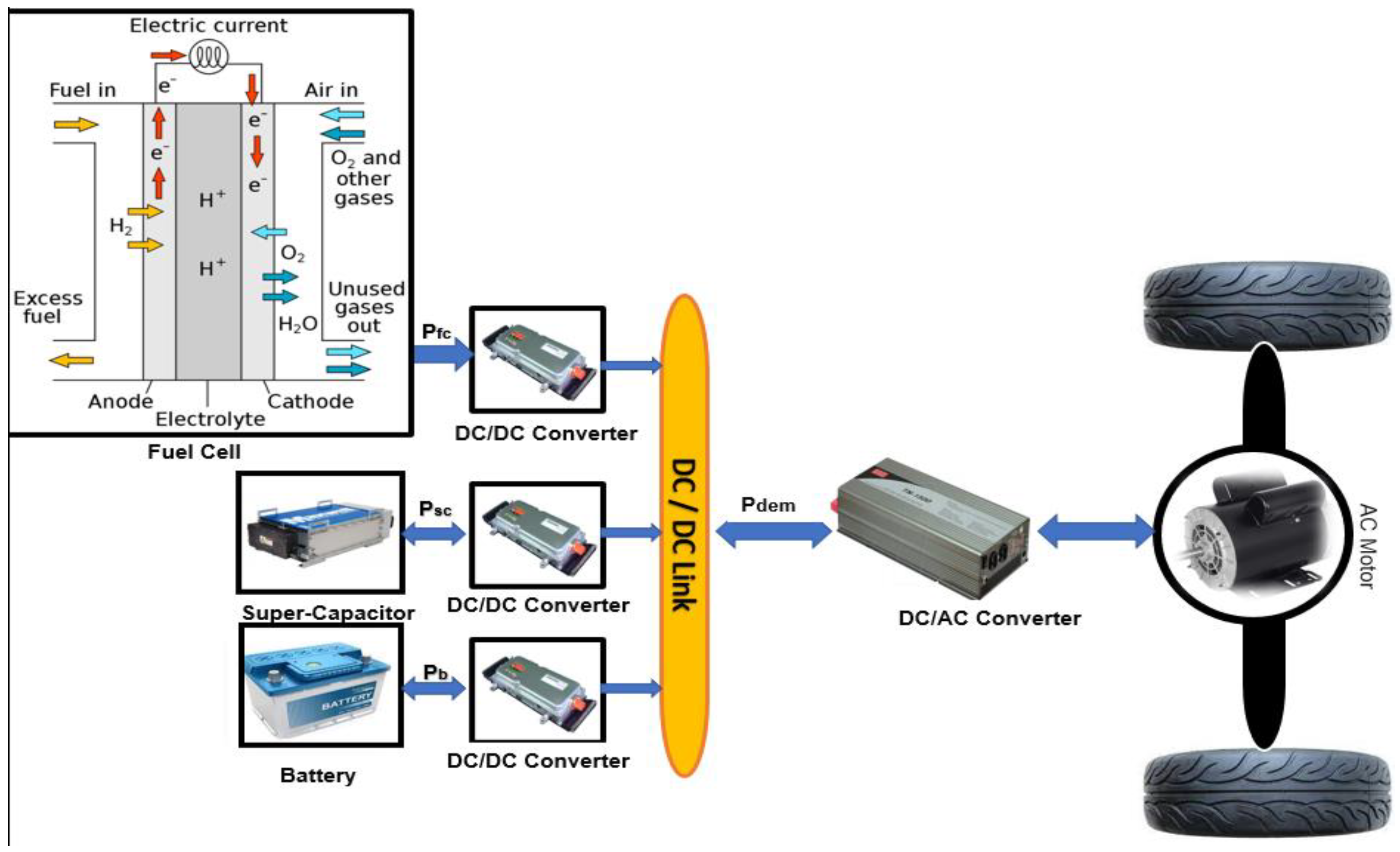
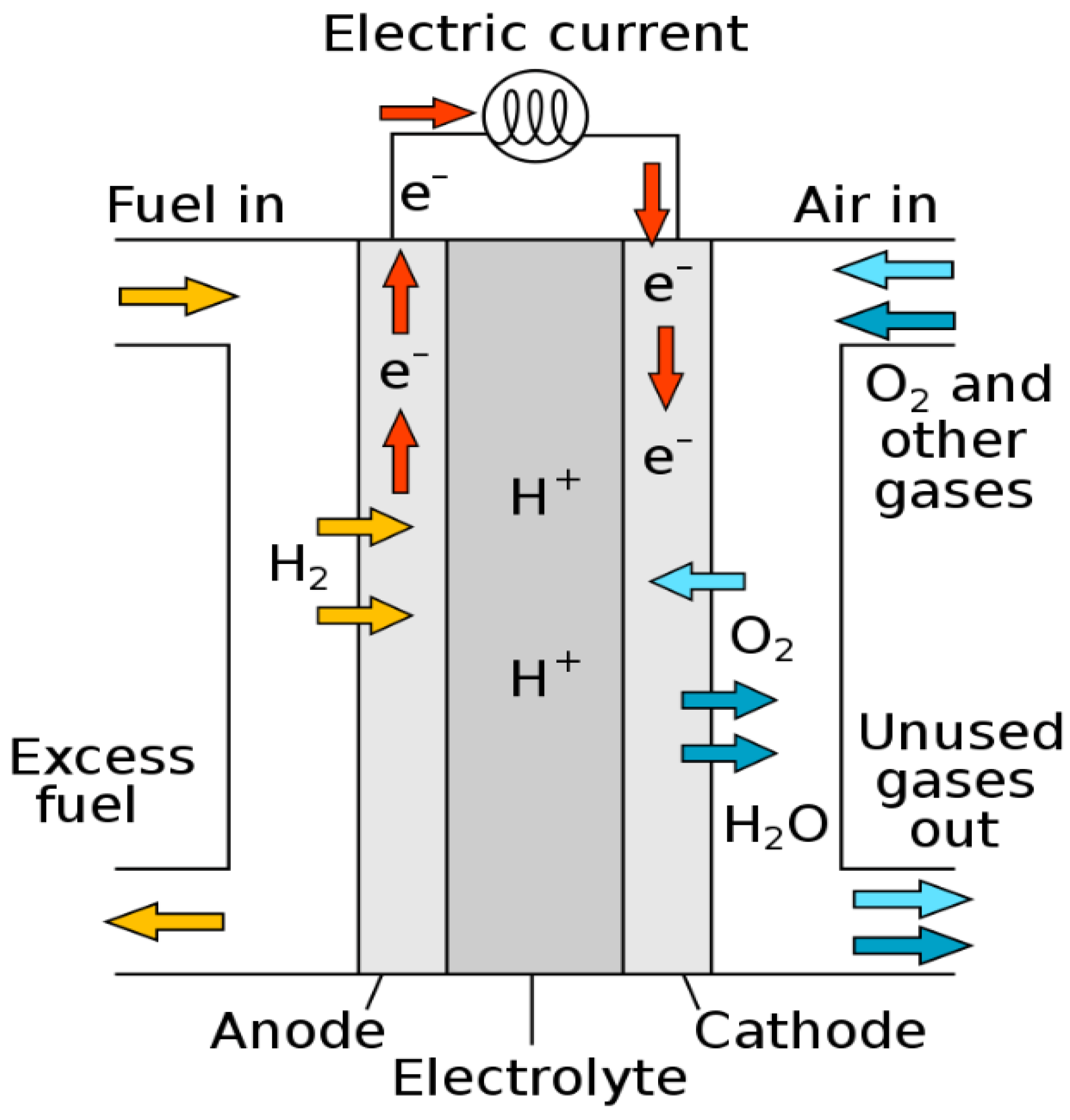
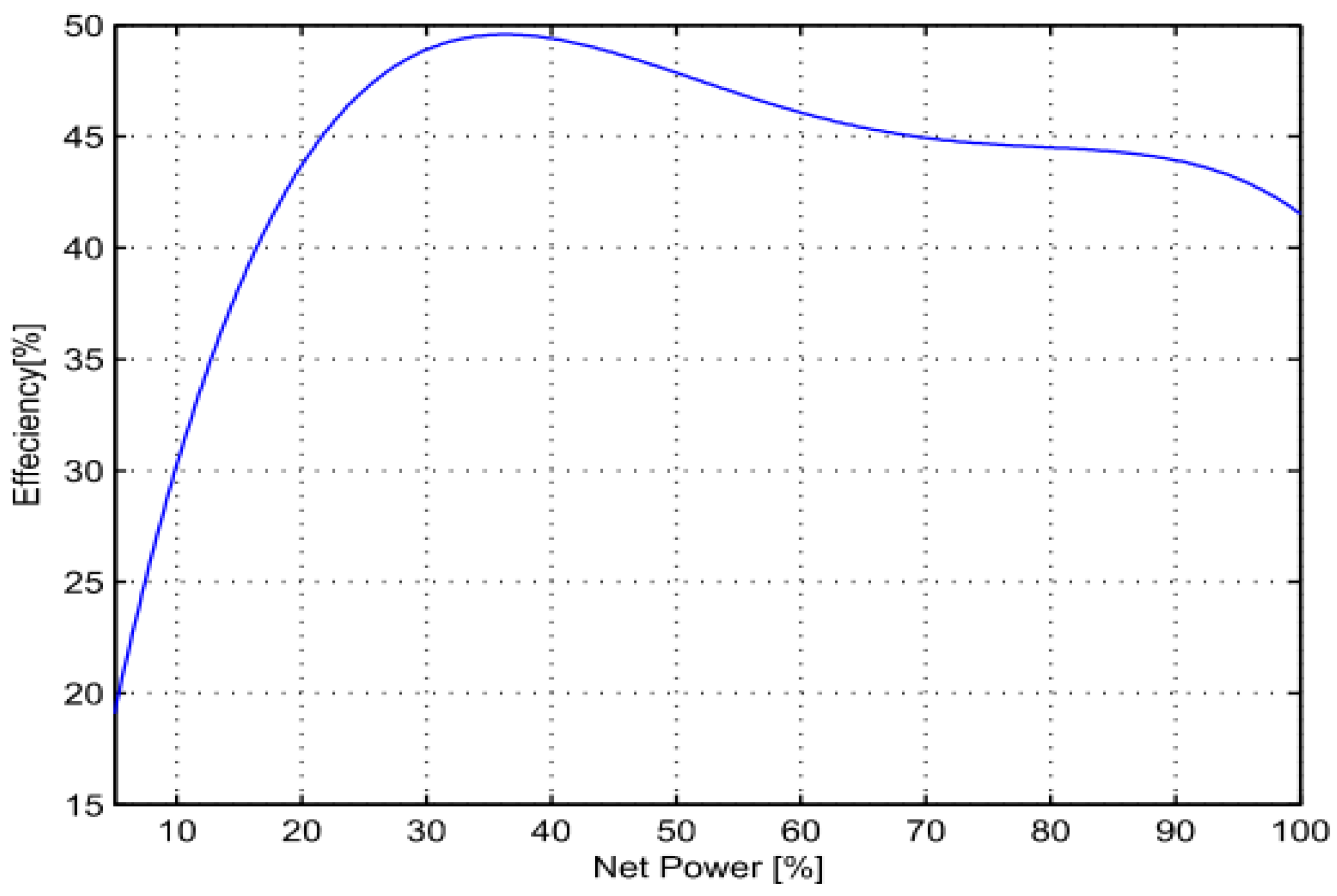
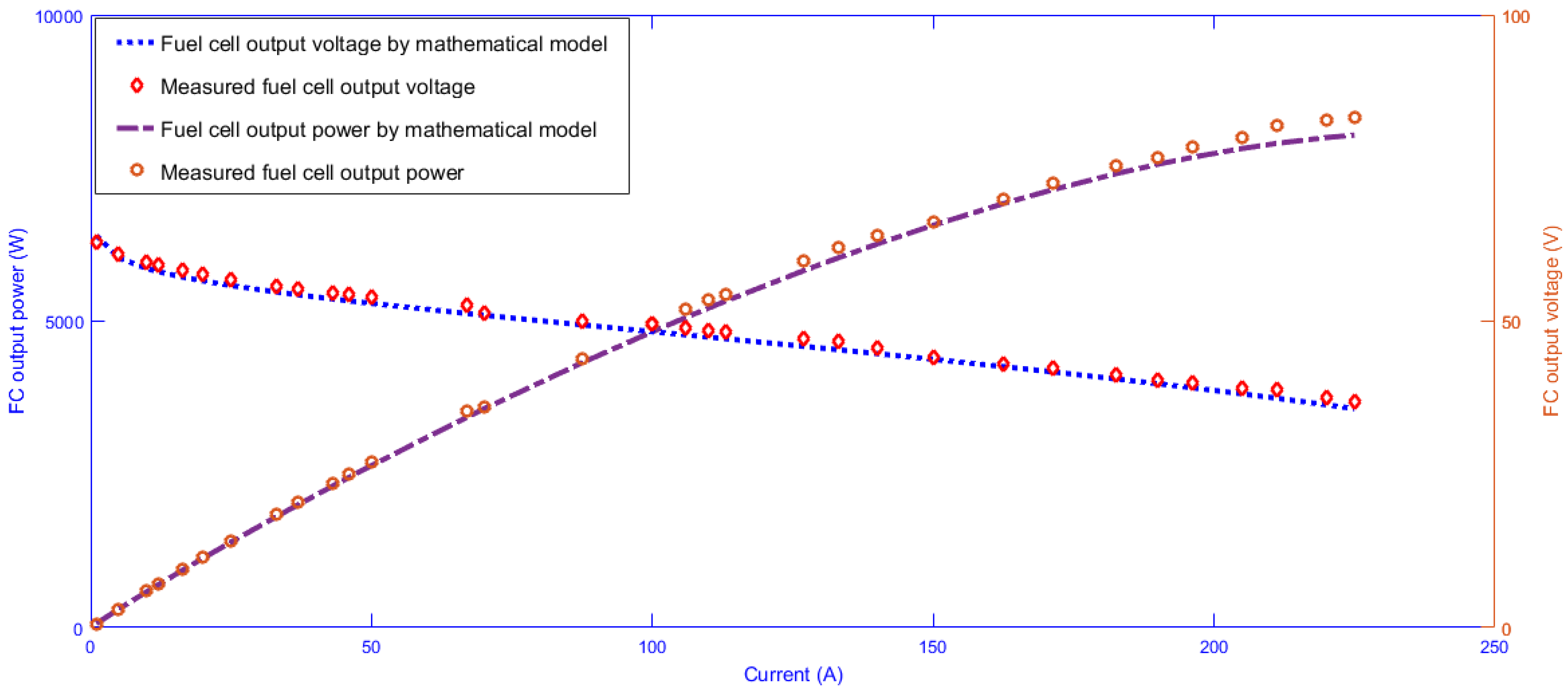
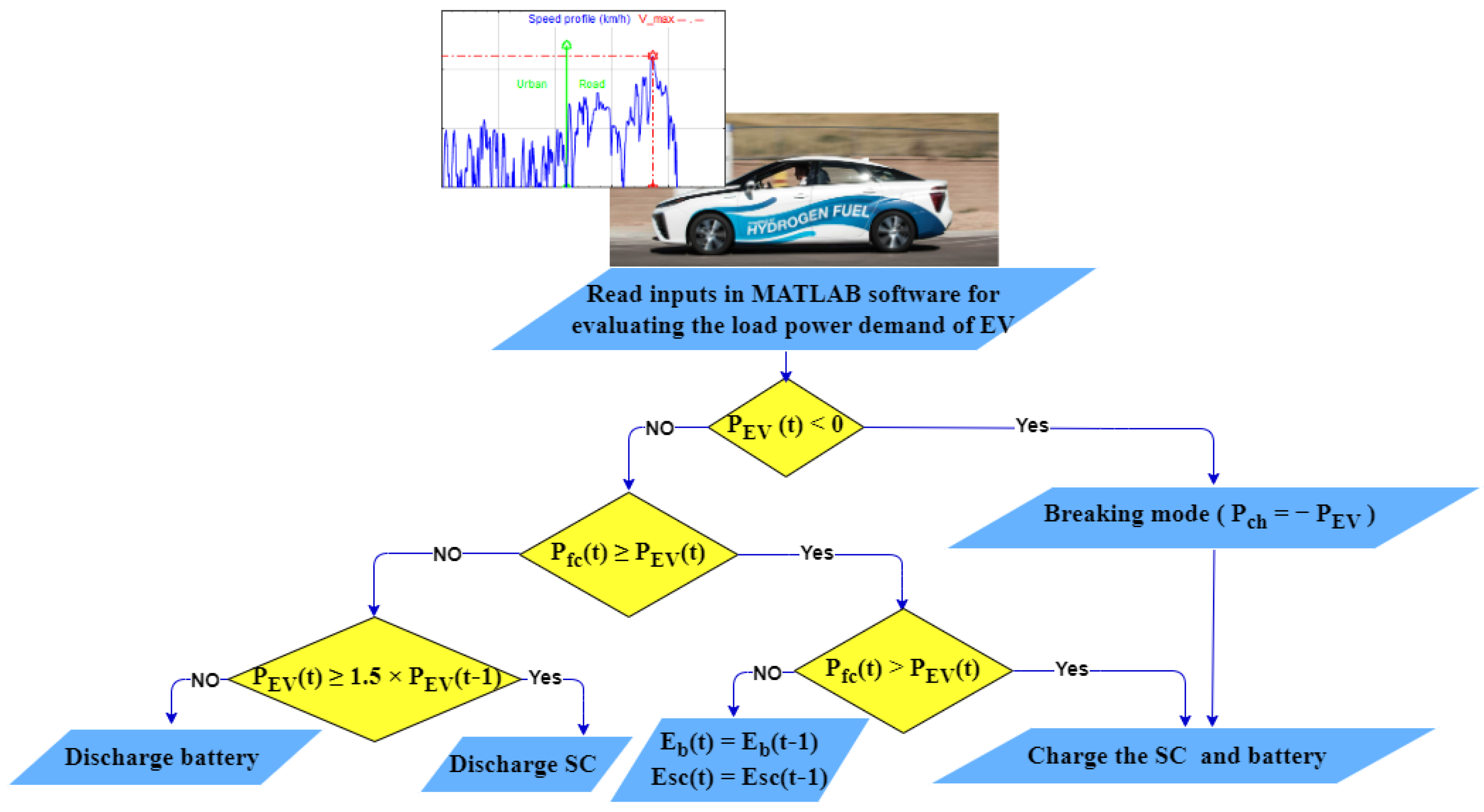
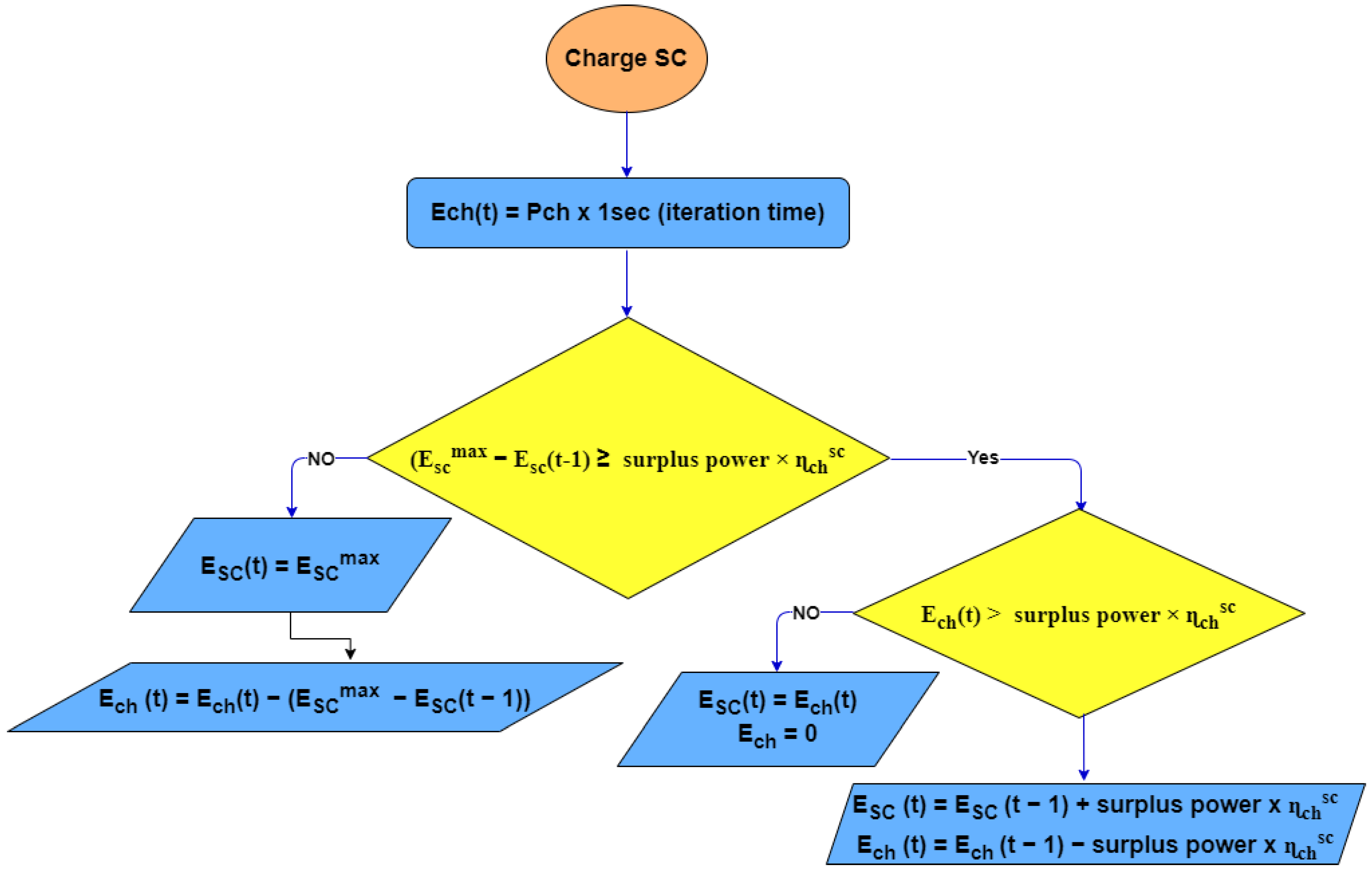
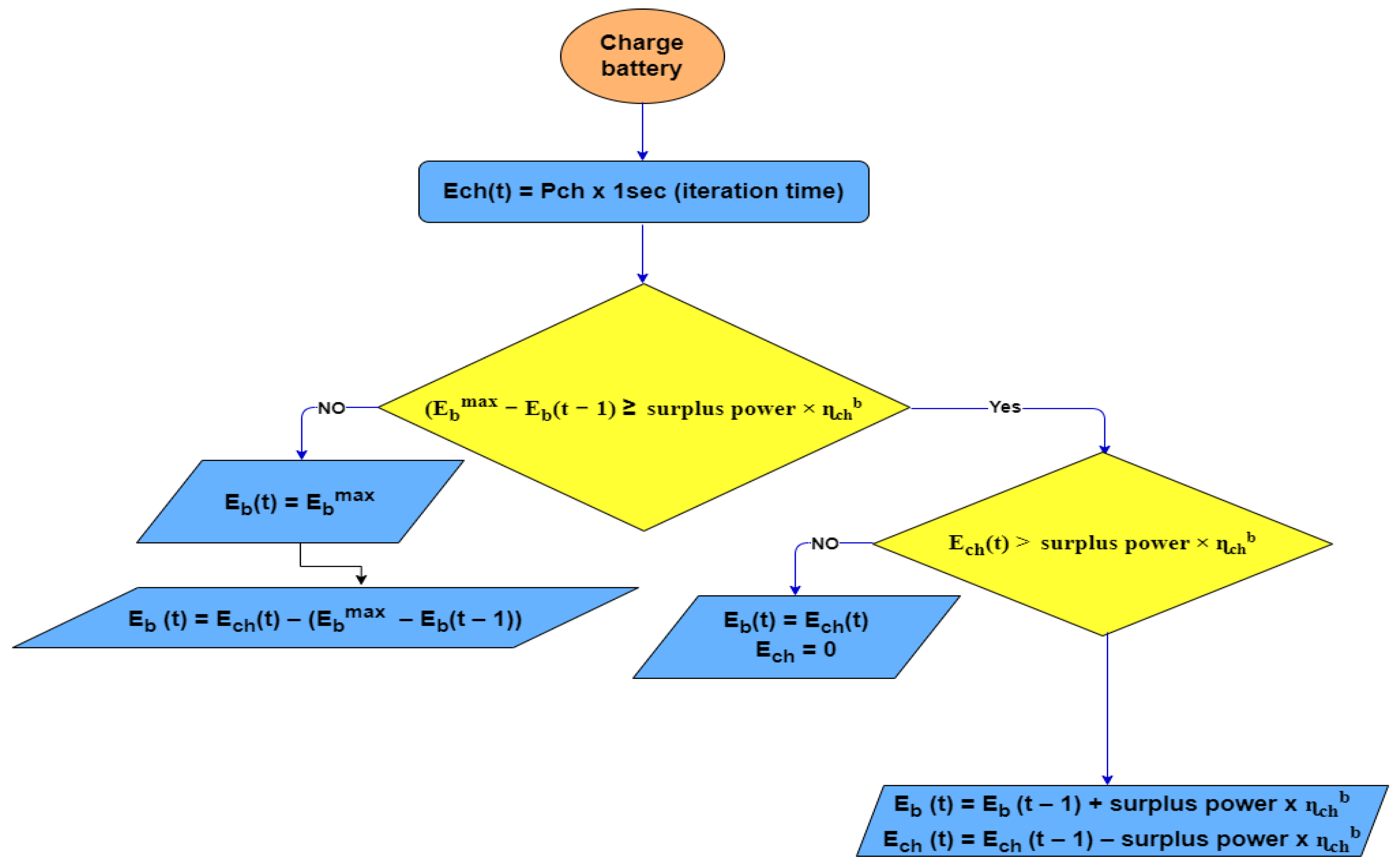
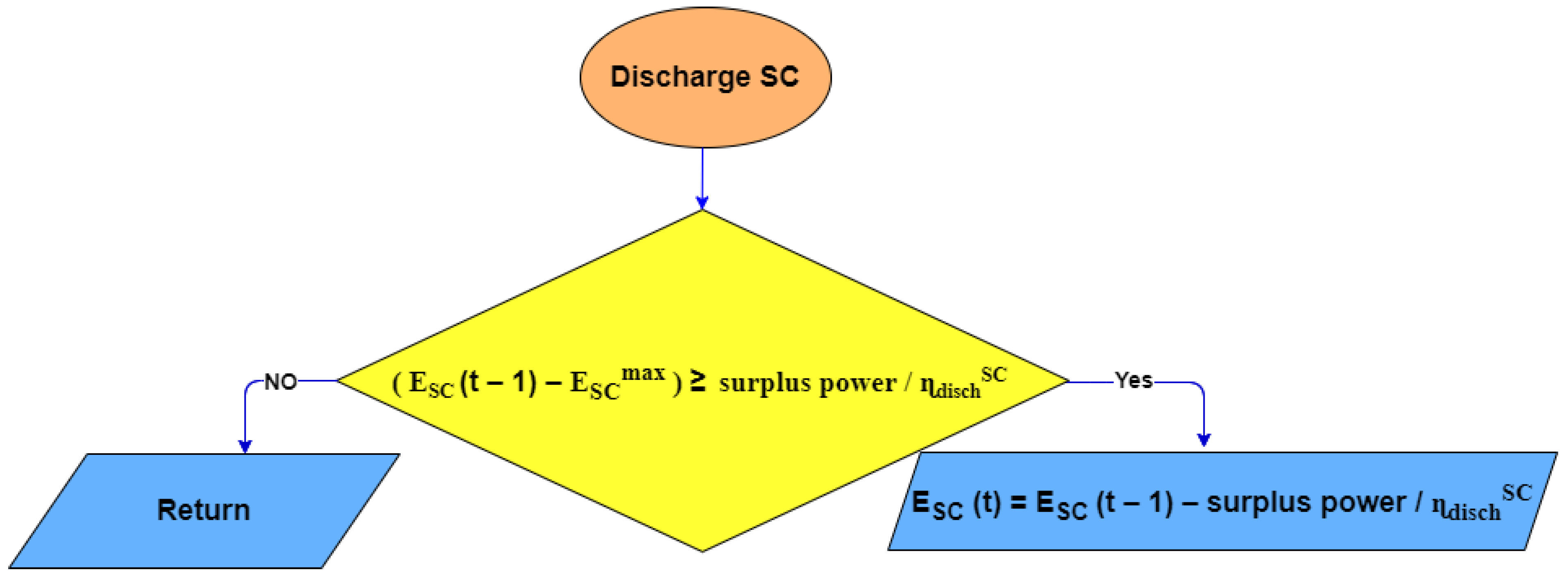
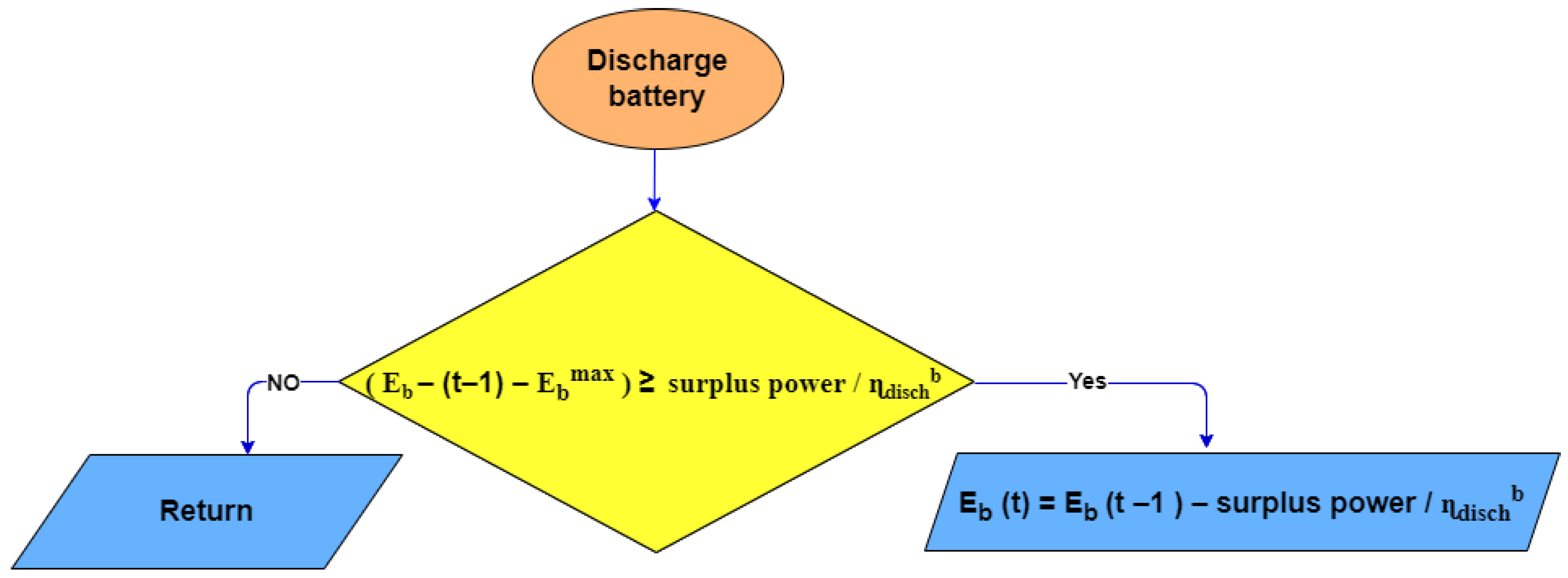
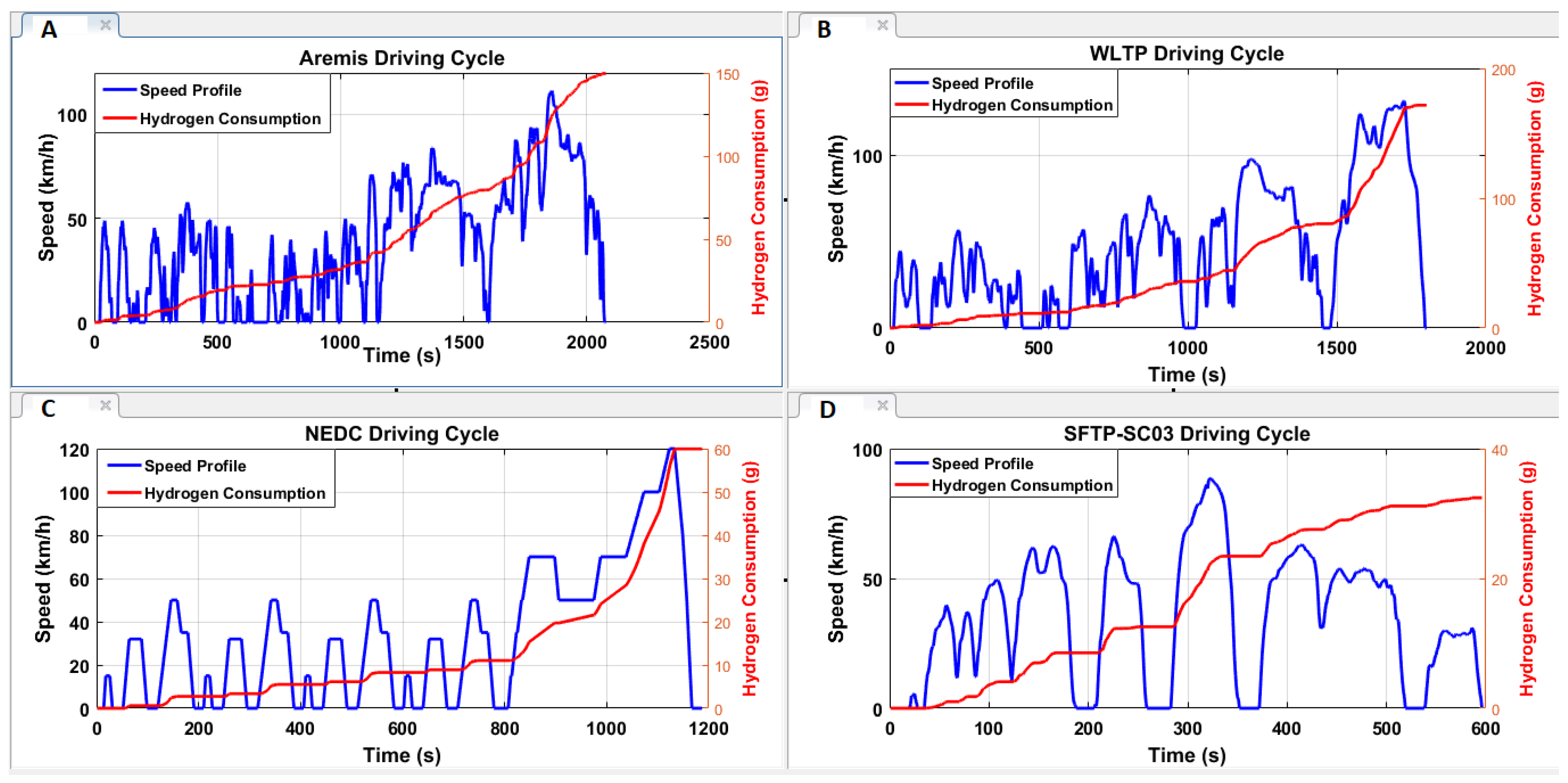
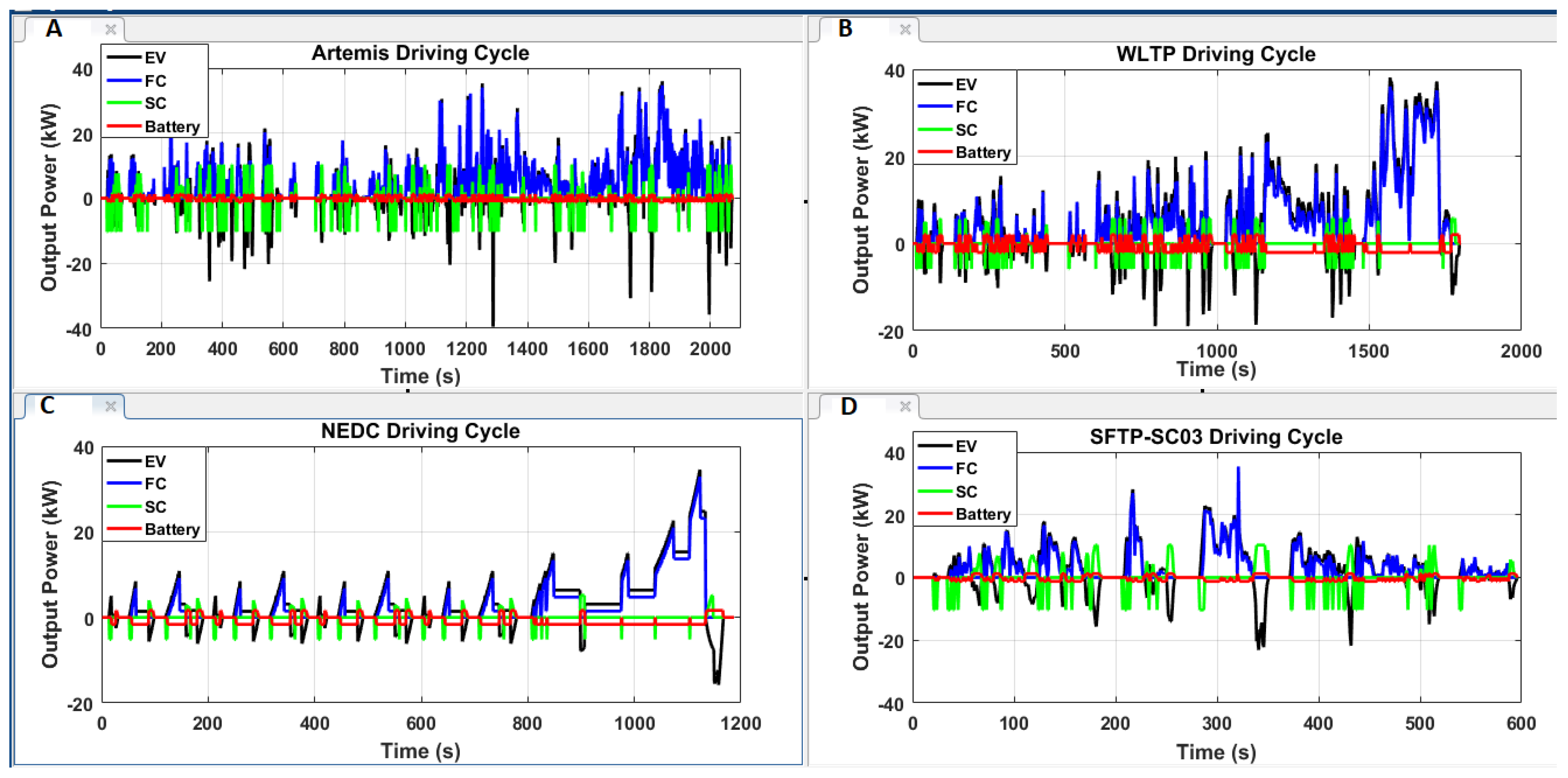
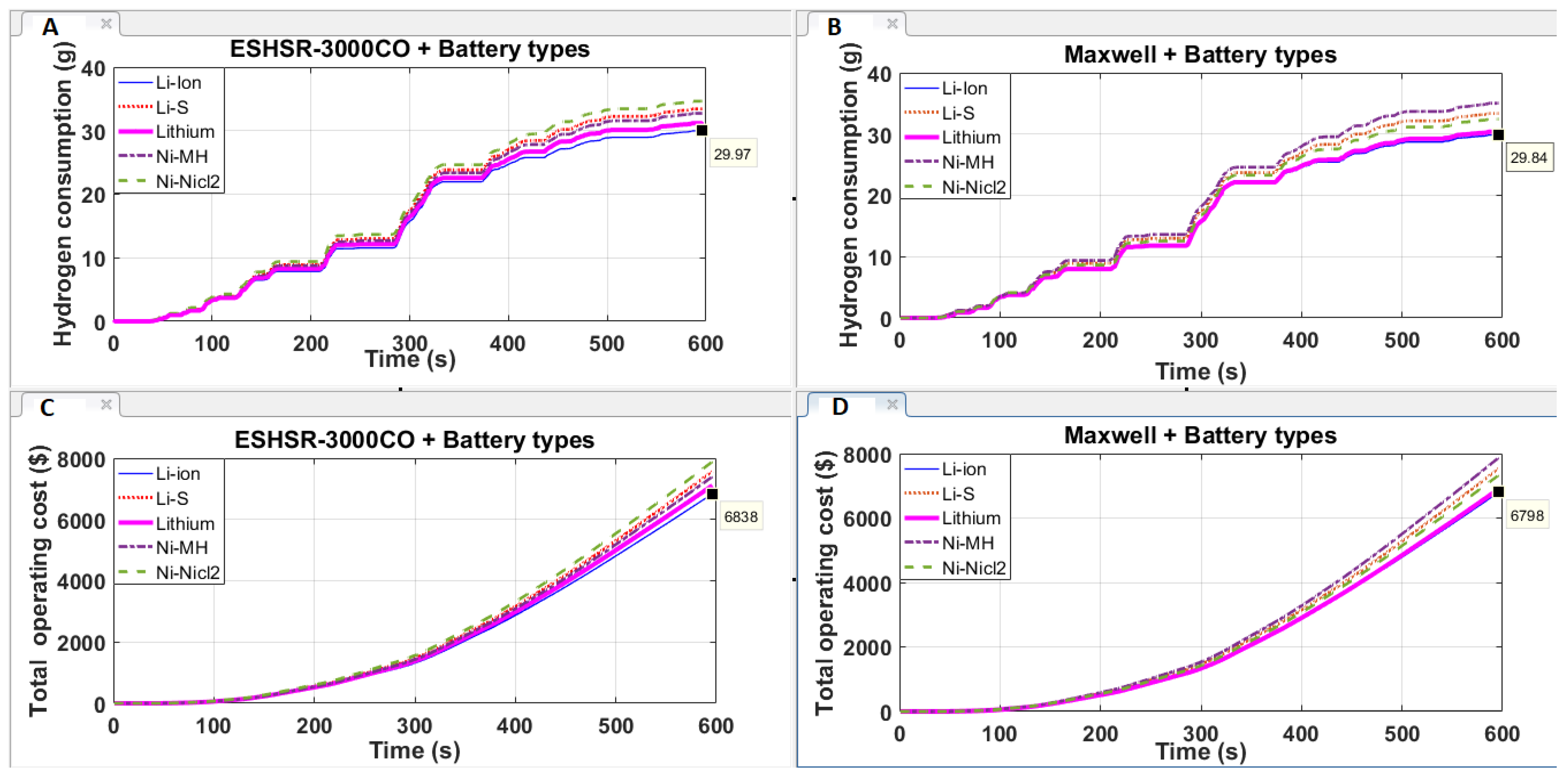
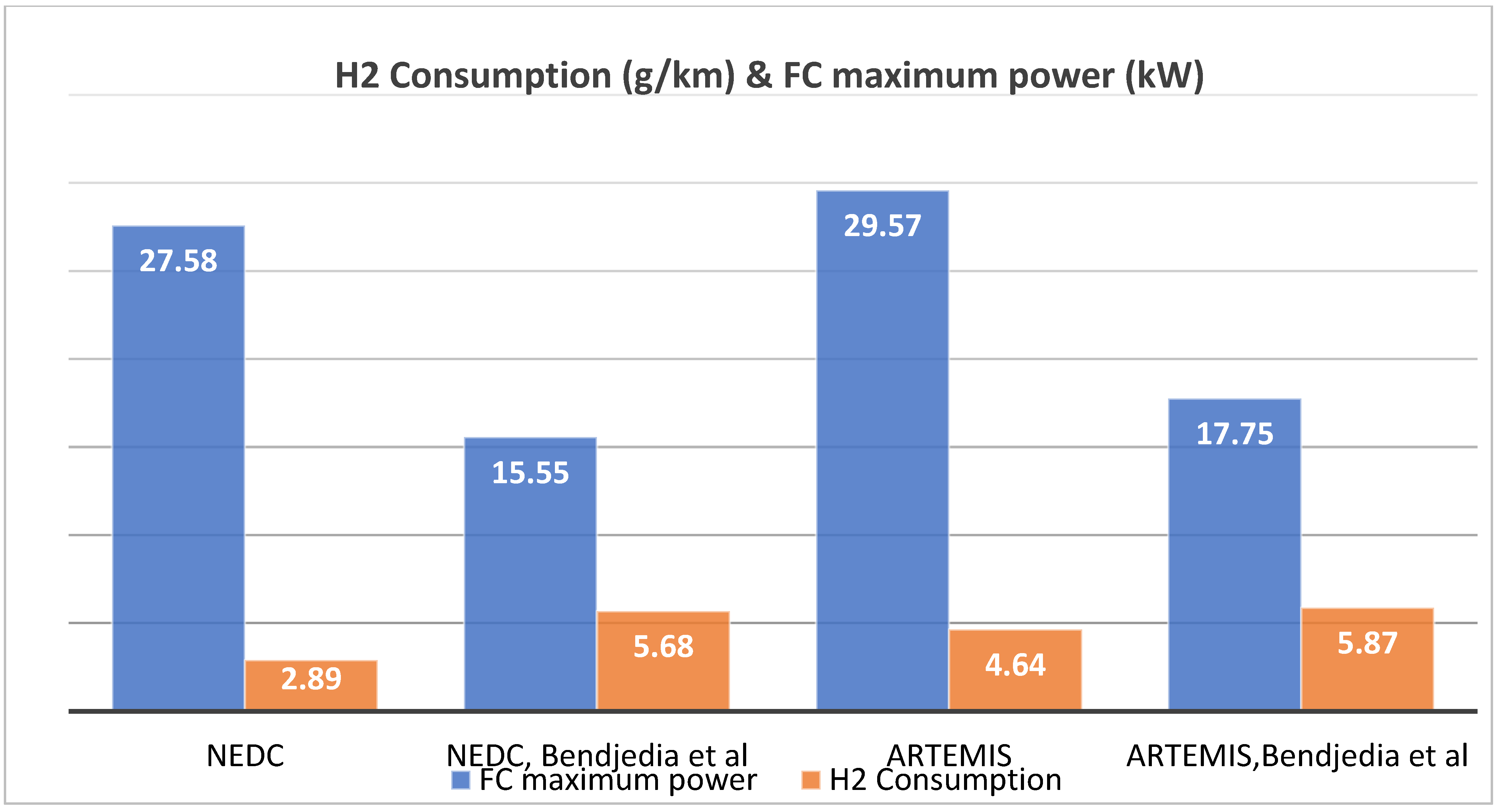
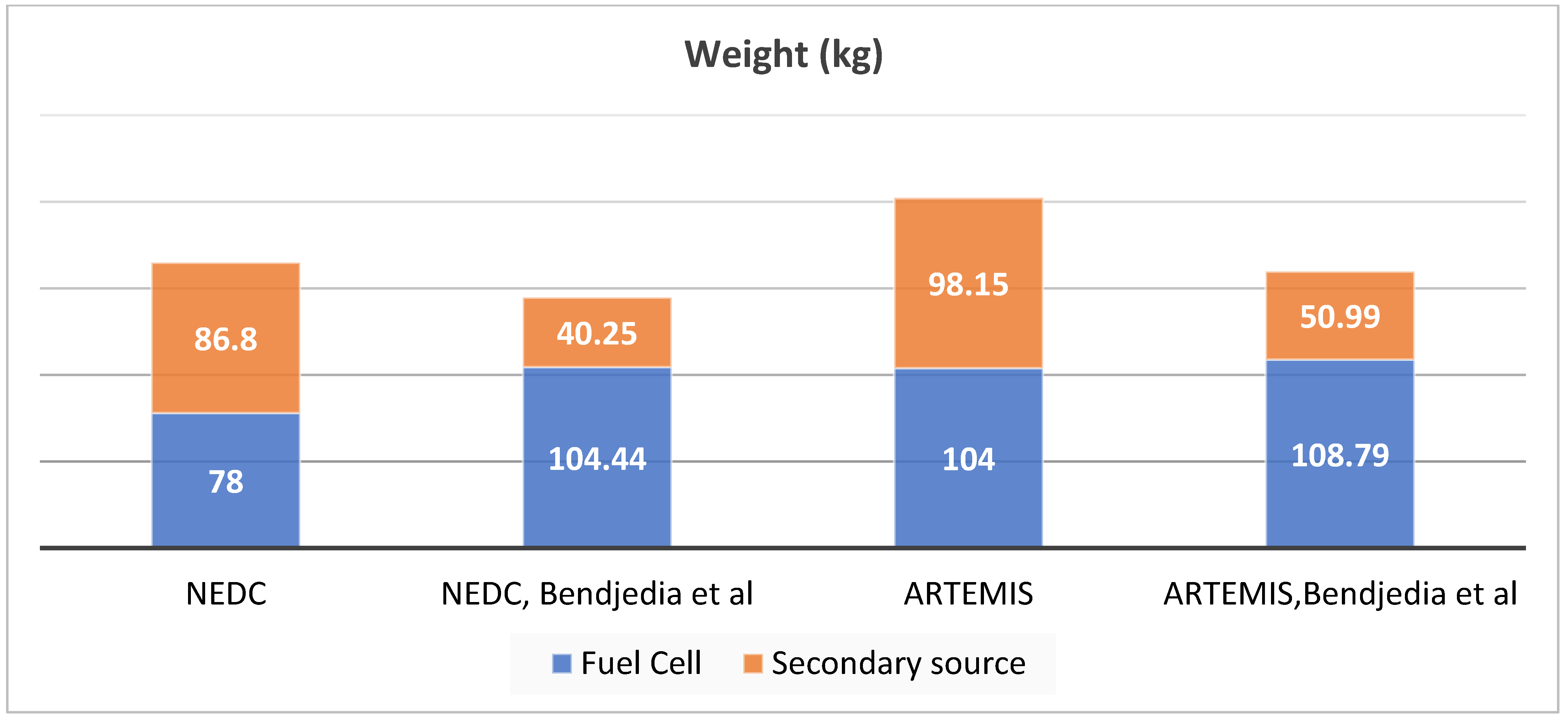
| Parameter | Value |
|---|---|
| Vehicle mass (kg) | 950 |
| Vehicle frontal area (m2) | 1.75 |
| Air density (ρ) (kg/m3) | 1.5 |
| Vehicle aerodynamic drag coefficient (Cx) (m2) | 0.3 |
| Static rolling resistance coefficient (C0) | 0.008 |
| Dynamic rolling resistance coefficient (C1) | 1.6 × 10−6 |
| Electric motor efficiency () (%) | 0.95 |
| Parameter | NedStack PS6, Fawzi et al. [20]. |
|---|---|
| −0.8535 | |
| 2.4316 | |
| 3.7545 | |
| −9.5400 | |
| λ | 13.0802 |
| 0.0136 | |
| (Ω) | 1 |
| Parameter | Value for Battery Types | Value for SC Type | Unit | |||||
|---|---|---|---|---|---|---|---|---|
| Lithium | Li-ion | Na-NiCl2 | Ni-MH | Li-S | Maxwell BCAP0003 | ESHSR-3000CO | ||
| Weight | 10.35 | 11.5 | 12 | 20 | 13 | 13.8 | 11.8 | Kg |
| Typical Cost | 150 | 165 | 170 | 190 | 200 | 5000 | 3500 | USD/kWh |
| Maximum Voltage | 78 | 75 | 71 | 75 | 72 | 800 | 650 | V |
| Nominal Capacity | 9.3 | 9.46 | 7.32 | 6.73 | 6.089 | / | / | Ah |
| (Charge/Discharge) Current | / | / | / | / | / | 100 | 100 | A |
| Maximum SOC | 100 | 100 | 100 | 100 | 100 | 100 | 100 | % |
| Minimum SOC | 20 | 20 | 20 | 20 | 20 | 20 | 20 | % |
| Initial Charge | 80 | 80 | 80 | 80 | 80 | 80 | 80 | % |
| Charging/Discharging time | >1800 | >1800 | >1800 | >1800 | >1800 | 1–30 | 1–30 | s |
| Charge/Discharge efficiency | 0.9 /0.85 | 0.9 /0.85 | 0.9/0.85 | 0.9/0.85 | 0.9/0.85 | 0.9/0.85 | 0.9/0.85 | / |
| Parameter | Value |
|---|---|
| Population size (N) | 30 |
| Maximum number of iterations (W) | 100 |
| [NBfcmin, NBfcmax] | [0, 10] |
| [NBscmin, NBscmax] | [0, 10] |
| [NBbmin, NBbmax] | [0, 10] |
| Hydrogen price | USD 2/kg |
| Electricity price | USD 0.138/kWh |
| Driving Cycles | Artemis | WLTP | NEDC | SFTP-SC03 |
|---|---|---|---|---|
| Decision Variables | ||||
| Distance (km) | 22.14 | 23.26 | 10.9314 | 5.78 |
| Max Speed (km/h) | 111.5 | 131.3 | 120 | 88.5 |
| Average Speed (km/h) | 38.37 | 46.49 | 33.1533 | 34.91 |
| FC max Power (kW) | 35.9446 | 38.1160 | 34.5545 | 35.3765 |
| Number of batteries | 3 | 5 | 3 | 3 |
| Number of SCs | 2 | 3 | 1 | 2 |
| Fuel Consumption (g/km) | 6.7589 | 7.3799 | 5.8761 | 5.61 |
| Operating Cost (USD/km) | 3.44 × 103 | 2.63 × 103 | 1.21 × 103 | 1.26 × 103 |
| Components weight (kg) | 165.62 | 220.37 | 151.82 | 165.62 |
Disclaimer/Publisher’s Note: The statements, opinions and data contained in all publications are solely those of the individual author(s) and contributor(s) and not of MDPI and/or the editor(s). MDPI and/or the editor(s) disclaim responsibility for any injury to people or property resulting from any ideas, methods, instructions or products referred to in the content. |
© 2023 by the authors. Licensee MDPI, Basel, Switzerland. This article is an open access article distributed under the terms and conditions of the Creative Commons Attribution (CC BY) license (https://creativecommons.org/licenses/by/4.0/).
Share and Cite
Djouahi, A.; Negrou, B.; Rouabah, B.; Mahboub, A.; Samy, M.M. Optimal Sizing of Battery and Super-Capacitor Based on the MOPSO Technique via a New FC-HEV Application. Energies 2023, 16, 3902. https://doi.org/10.3390/en16093902
Djouahi A, Negrou B, Rouabah B, Mahboub A, Samy MM. Optimal Sizing of Battery and Super-Capacitor Based on the MOPSO Technique via a New FC-HEV Application. Energies. 2023; 16(9):3902. https://doi.org/10.3390/en16093902
Chicago/Turabian StyleDjouahi, Abdeldjalil, Belkhir Negrou, Boubakeur Rouabah, Abdelbasset Mahboub, and Mohamed Mahmoud Samy. 2023. "Optimal Sizing of Battery and Super-Capacitor Based on the MOPSO Technique via a New FC-HEV Application" Energies 16, no. 9: 3902. https://doi.org/10.3390/en16093902
APA StyleDjouahi, A., Negrou, B., Rouabah, B., Mahboub, A., & Samy, M. M. (2023). Optimal Sizing of Battery and Super-Capacitor Based on the MOPSO Technique via a New FC-HEV Application. Energies, 16(9), 3902. https://doi.org/10.3390/en16093902







